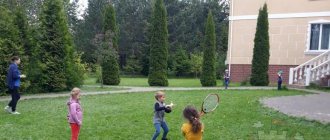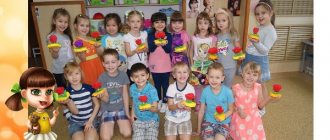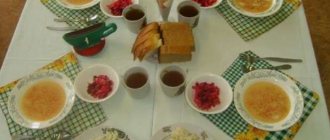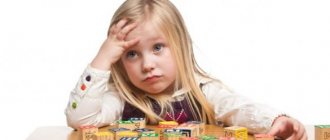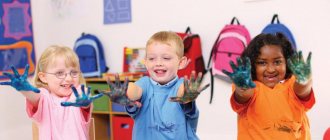Consultation "Conducting a walk in kindergarten"
Walk
Organizing and conducting walks in kindergarten.
A walk is a very important routine moment in the life of children in preschool educational institutions.
Purpose of the walk
– health promotion, fatigue prevention, physical and mental development of children, restoration of functional resources of the body reduced during activity.
Walking tasks
:
Physical development of children
– a walk is the most accessible means of hardening a child’s body, helping to increase its endurance and resistance to adverse environmental influences, especially colds.
Optimization of physical activity - while walking, children move a lot, and movements increase metabolism, blood circulation, and improve appetite. Children learn to overcome obstacles, become more agile, dexterous, courageous and resilient. They develop motor skills and abilities, strengthen the muscular system, and increase vitality.
Mental development of children -
children get a lot of new impressions and knowledge about their surroundings: about the work of adults, about transport, about traffic rules, etc. from observations they learn about the features of seasonal changes in nature, notice connections between various phenomena, and establish elementary dependencies. Observations arouse interest, questions to which they strive to find an answer. All this develops observation, expands ideas about the environment, awakens the thoughts and imagination of children.
Solving problems of moral education
– acquaintance with the hometown, its attractions, the work of adults, the importance of work for the lives of children. Familiarization with the surrounding environment helps to instill in children a love for their hometown. Kids work in the flower garden - they are taught hard work, love and respect for nature. They learn to notice her beauty. The abundance of colors, shapes, sounds in nature, their combination, repetition and variability - all this causes joyful experiences in children.
Thus, properly organized and thoughtful walks help to achieve the goals of the comprehensive development of children. Children are allowed to spend up to four hours a day outdoors. The daily routine of the kindergarten includes a daytime walk before lunch after educational activities and an evening walk after the afternoon snack. To achieve a healing effect in the summer, the daily routine provides for children to spend maximum time in the fresh air with breaks for meals and sleep.
Planning a walk.
When planning a walk, the main task of the teacher is to provide active, meaningful, varied and interesting activities for children: games, work, observations. When planning the content of a walk, the teacher provides for an even alternation of calm and motor activities of children, the correct distribution of physical activity throughout the walk. The sequence and duration of different types of activities changes taking into account specific conditions: time of year, weather, age of children and the nature of their previous activities. The content of evening walks is planned taking into account all the children’s previous activities.
Contents of children's activities during a walk. The content of children's activities during a walk depends on the time of year, weather, theme of the week, previous educational activities, interests and age.
Structure of the walk.
- Observation.
- Physical activity: outdoor games, sports games, sports exercises.
- Children's labor at the site.
- Individual work with children.
- Independent play activity.
Observation.
A large place is given to observations (pre-planned) of natural phenomena and social life. Observation can be carried out with a whole group of children, with subgroups, as well as with individual children. The teacher involves children in observations in order to develop attention and interest in nature and social phenomena. The surrounding life and nature provide an opportunity to organize interesting and varied observations. For example, you can pay attention to the clouds, their shape, color, and compare them with images known to children. Monitoring of the work of adults who work near the kindergarten, for example construction workers, should also be organized.
Physical activity. The leading place during the walk is given to games, mainly active ones. They develop basic movements, relieve mental stress, and cultivate moral qualities.
During the walk we include outdoor games:
2-3 games of high mobility;
2-3 games of low and medium mobility;
Games of children's choice.
An outdoor game can be played at the beginning of a walk if the educational activity involved children sitting for a long time. If they go for a walk after a music or physical education lesson, then the game can be played in the middle of the walk or half an hour before it ends.
The choice of game depends on the time of year, weather, air temperature.
On cold days, it is advisable to start your walk with games of high mobility associated with running, throwing, and jumping. These games help children better cope with cold weather;
In damp, rainy weather (autumn, spring), sedentary games that do not require a lot of space should be organized;
On warm spring, summer days and early autumn, games with jumping, running, throwing, and balance exercises should be played;
In hot weather, water games are played;
The use of plotless folk games with objects: ring throw, skittles; elements of sports games: gorodki, badminton, volleyball, football, hockey, etc.;
Useful games that expand children's knowledge and understanding of the environment. These are didactic games (cubes, lotto) and role-playing games (family games, astronaut games, hospital games, etc.). The teacher helps develop the plot of the game, select or create the material necessary for the game;
Outdoor games can be supplemented or replaced with sports exercises, sports games, games with elements of competition. Conduct sports entertainment. (In our kindergarten, according to the plan, physical education classes are taken outside once a week).
Labor activity of children
. The content and forms of its organization depend on the weather and
time of year.
So, in the fall, children collect flower seeds and harvests from the garden; In winter they can shovel snow and make various structures out of it.
The teacher can involve children in collecting toys and providing all possible assistance in putting things in order in the area;
It is necessary to strive to make child labor joyful, helping children to master useful skills and abilities. Labor tasks should be within the capabilities of children and, at the same time, require certain efforts from them. The teacher makes sure that they do their work well and finish what they started.
Individual work with children
. The teacher, in accordance with planning (based on the diagnostic results of children), carries out individual work on the cognitive-speech, social-personal, physical or artistic-aesthetic development of children. For example, for some he organizes games with a ball, throwing at a target, for others - balance exercises, for others, jumping off stumps, stepping over objects. Work is also carried out to develop the child’s speech: learning a nursery rhyme or a short poem, reinforcing a sound that is difficult to pronounce, etc. You can carry out art work, theatrical performances in the warm season, etc.
Each of the required components of the walk lasts from 7 to 15 minutes and is carried out against the backdrop of children’s independent activity
The teacher must guide the independent activities of children:
ensure their complete safety, teach them how to use the aids in accordance with their intended purpose, and constantly monitor their activities throughout the walk. The teacher makes sure that all the children are busy, not bored, and that no one gets cold or overheated. It attracts those children who run a lot to participate in quieter games.
The effectiveness of walks in a preschool institution is largely determined by an understanding of their significance, which consists in:
-satisfy the child’s natural biological need for movement;
- ensure the development and training of all systems and functions of the child’s body through motor activity and physical activity specially organized for this age;
-develop skills in different types of movements;
-promote the development of the child’s motor qualities and abilities;
-stimulate the functional capabilities of each child and activate children's independence;
- create optimal conditions for the versatile development of children: activation of mental activity, search for adequate forms of behavior, formation of positive emotional and moral-volitional manifestations of children.
SANPIN REQUIREMENTS FOR ORGANIZING A WALK
It is perhaps difficult to overestimate the importance of a walk in kindergarten. During a walk, children move actively, breathe fresh air, learn about the world around them, and get accustomed to work. All this is beneficial for the health, physical and mental development of children.
Sanitary standards stipulate that the daily duration of children's walks is at least 3-4 hours.
The walk is organized 2 times a day: in the first half - before lunch and in the second half - after a nap or before the children go home. When the air temperature is below -15°C and the wind speed is more than 7 m/s, the duration of the walk is reduced. The walk is not carried out at an air temperature below -15 ° C and a wind speed of more than 15 m/s for children under 4 years old, and for children 5–7 years old - at an air temperature below minus 20 ° C and a wind speed of more than 15 m/s;
During the walk, pupils are provided with physical activity and reasonable clothing depending on weather conditions, including in winter.
The reason for a child’s frequent illness cannot be directly dependent on the activities carried out in kindergarten. On the contrary, the kindergarten implements physical education and health activities aimed at strengthening the health of each child.
When organizing walks in the autumn and winter, you should:
1. Dress children in accordance with temperature conditions, avoid: - frostbite, hypothermia or overheating of the child’s body;
— getting children's clothes and shoes wet; 2. Protect children from exposure to the following dangerous factors characteristic of the autumn-winter period: - injuries during games on areas that are not cleared of snow and ice; — injuries from icicles falling from roofs, hanging blocks of snow during the thaw period; - falling from a slide, in cases where the teacher does not have insurance (provide control and direct insurance by the teacher while sliding down a slide, climbing, jumping from a hill, sports equipment, throwing); - injury: from metal or wooden stands of objects sticking out of the ground, low stumps on areas for outdoor games, injections from broken glass, dry branches, twigs on trees, bushes, splinters from sticks, boards, wooden toys, etc.; — injuries to the legs of pupils: in the presence of holes and potholes in the area, when jumping from stationary equipment without the teacher’s insurance; — injuries when sliding on an ice path; — when organizing the work of preschool children; - injuries, bruises during games with sports elements; - injuries, bruises during games on a wet and slippery surface; - injuries, bruises when sliding down ice slides, on sleds, while moving in icy conditions on slippery paths, external steps, areas not cleared of snow, ice and not sprinkled with sand; — injuries from touching metal structures with exposed parts of the body (face, hands, tongue, lips) on a frosty day; Avoid:
- infection with gastrointestinal diseases, acute respiratory infections, if the child puts dirty and cold snow or icicles in his mouth. - clear the roofs of all buildings from snow, sprinkle icicles with sand. Each teacher and all substitute teachers must teach children to recognize dangerous situations in illustrations and explain to children. Agree with the head nurse and manager about the possibility of going for a walk depending on the weather conditions and air temperature. The teacher must inspect the clothes and shoes of the pupils for compliance with weather conditions. Children should always be provided with spare things in case of bad weather, which parents bring in advance for this purpose;
Safety requirements while walking
1. It is not allowed to organize walks, work in one play area at the same time for 2 groups of pupils, the presence of parents on an evening walk 2. The teacher provides supervision, control over the calm exit of pupils from the premises and descent from the porch, do not run, do not push, when descending and ascending to the 2nd floor, hold onto the railings, do not carry large toys and objects in front of you that block the view of the path, etc.
Additional safety requirements during a walk in winter:
1. Ensure control and direct insurance by the teacher of pupils while sliding on ice paths, riding sledding;
2. Make sure that when sledding, the next child waits patiently until the child sliding in front of him reaches the end of the ramp or slide; 3. When sledding down a hill, do not allow children to sit with their backs to the slope; 4. Make sure that children do not put dirty snow or icicles in their mouths; 5. If frost and wind become stronger, take children to the kindergarten premises; Safety requirements in situations during a walk:
1. All employees temporarily replacing the teacher in the group take on the functions of rescuing children.
2. If unforeseen situations arise, it is necessary to: - ensure the safety of children; — make sure there is no dangerous situation; — inform the administration about the incident, provide first aid in case of an accident; — notify the rescue service by phone if the situation requires it. Safety requirements at the end of the walk
1. Organize a calm entry of pupils into the kindergarten premises (the 1st subgroup passes and undresses under the supervision of an assistant teacher, the 2nd - under the supervision of a teacher). 2. Clean students’ outer clothing and shoes from snow, dirt, and sand. 3. Check how the students put their clothes in the lockers. If necessary, change the pupils into dry clothes and underwear. 4. Organize hygiene procedures: visiting the toilet, washing hands with soap. 5. Ensure drying of wet clothes and shoes after rain or in winter
Types of walks in kindergarten
1. At the venue:
• on the territory of the kindergarten;
• outside the territory of the kindergarten (possible in older groups, over short distances).
2. By content:
• traditional, which includes children’s work activities (cleaning up leaves, snow, etc.), active and quiet games, etc.;
• thematic: consisting of observations and conversations on a specific topic (animals, clouds, trees, city transport, etc.), can be a street theater performance, a quest with overcoming simple obstacles - requires a pre-prepared script;
• targeted: organized exit outside the territory of the kindergarten, over a short distance (up to 2 km);
• excursion (usually a museum tour): once a month, starting from the middle group;
• hike: can be carried out 1-2 times a year in older groups.
Conclusion.
So, the process of raising children is continuous. Great potential opportunities for the comprehensive harmonious development of a child’s personality are inherent in the process of educational work with children in a walking environment. Here, like nowhere else, children are provided with unique conditions for all-round development; their needs for active movements, independent actions when getting to know the world around them, new vivid impressions, and free play with both natural materials and toys are fully satisfied. However, due to age characteristics, children themselves cannot use all the walking time with maximum benefit for their development. An adult must pedagogically correctly guide their activities.
In the process of daily outdoor games and physical exercises during walks, children’s motor experience expands and their existing skills in basic movements are improved; agility, speed, endurance develop; independence, activity, positive relationships with peers are formed
Pedagogy of walking
(printed with abbreviations)
A walk, regardless of its type, has a certain methodological logic.
Organizing time
includes: dressing children (the teacher must ensure that children dress for the weather and in accordance with the planned activities during the walk), instructions about the time and purpose of the walk, rules of behavior and safety precautions, distribution of specific instructions. It is better to conduct such an introductory briefing conversation in the school yard at a permanent meeting place.
So that after classes in the classroom, a walk gives children a feeling of freedom, but at the same time the teacher has the opportunity to control the situation of the walk, it is worth introducing the “laws of walking” into everyday life. Here are some options tested in practice:
• “signal law”: if the teacher clapped his hands three times and said: “Everyone gather,” then you need to leave what you are doing and run to the gathering place;
• “law of the circle”: if the teacher raised a flag (you can come up with another bright attribute), then you need to stand in a circle next to it. The circle is necessary when you need to tell something interesting during a walk, give a short briefing before the game, or summarize the walk;
• “law of intelligence”: younger schoolchildren go for a walk and return from it, as a rule, when classes are in session in high school. This law requires you to leave school and return to it quietly, like scouts.
Main part
walks include the movement of children along the intended route and the completion of assigned tasks, organized observation, a conversation with the teacher on the topic of the walk, and free independent activity of schoolchildren.
Brief summary
walks at a permanent gathering place.
Strip
children, hygiene procedures.
If the purpose and content of the walk require the organization of games, you should take care of the playground. You can use a standard school playground, but it is better for groups, and especially after-school classes in elementary schools, to equip a special playground with a gazebo or rain canopy, swings, sports equipment for the height of younger students, an obstacle course (various supports and climbing frames) "- multi-tiered structures on which you can hang, swing, and from which you can jump). To carry out walks, you also need equipment: sleds, skis, balls, jump ropes, etc.
As a rule, most of the walks are spent in the school yard. There are many reasons for this: there is a busy highway around the school, and it is difficult for a teacher to ensure the safety of children alone; You can easily bring the necessary play equipment to the schoolyard and use the equipment from the sports ground. And simply, purely psychologically, being in the school yard is like being at home, it gives the teacher a feeling of protection from any surprises.
But if walks take place only in the school yard, then the play resource of the yard is soon exhausted for children. In this case, what will normal primary schoolchildren do during a walk? There are several variations of their typical behavior:
• they will begin to explore the informal areas of the school yard: a garbage dump, a water hole, an old barn, a basement;
• they will begin to creatively rethink the familiar subject environment of the yard: master jumping on old car tires that the caretaker had stored for improvised flower beds, build a “headquarters” from discarded stands, paint the wall of a building with colored chalk;
• they will use trial and error to figure out what actions can be taken on the tree: climb, jump, swing on the branches...
In themselves, such actions of children in the schoolyard are natural: they cannot walk in pairs near the porch or sit on a bench for the entire walk. Children of primary school age experience a normal need to actively interact with objects that attract their attention, to saturate their time outside the classroom with vivid fantasies and searches for new events. Therefore, an after-school teacher, on the one hand, should give children the opportunity to fulfill these needs during a walk in the schoolyard, and on the other hand, should be aware of the variety of types of walks outside the school grounds and thereby help younger schoolchildren in expanding the boundaries of their exploration of the world.
So that our conversation about such walks has some kind of system, let’s try to organize their species diversity.
...The typology of walks, in our opinion, should be based on the leading activity within the framework of which the main health-improving, educational and developmental tasks are solved in a given walk.
Sports walk. During such a walk, children play sports games: hockey, football, volleyball, skiing and skating. But often in a group the boys are eager to kick the puck, but the girls are not interested. Sports equipment is not always available for everyone. Then you should give preference to ball games, fun relay races, and jumping ropes.
Walk-observation. Its main content is most often associated with targeted observations by primary schoolchildren of seasonal changes in nature, features of the flora and fauna. Its location is the school garden, the nearest square, park, green area near the school.
Already on the way, the teacher asks the children to pay attention to what trees and shrubs grow along the street, what birds winter in the city. This walk may include game elements, such as a “Who is the most observant?” competition. The teacher asks each student to notice around and remember as many types of trees, shrubs, flowers as possible in 5 minutes (time is measured by the clock), or the competition is complicated by the task: who can best tell about the named trees and shrubs.
It is useful to make the most ordinary phenomena, to which they often do not know how to react, the object of observation for children. For example, ask them to take a closer look at the clouds: what size, shape, what they look like, how they move; or take a closer look at the snow: how wet, heavy or creaky it is from the frost, talk about what it may depend on... Such simple observations, if carried out in a system, allow children, even living in the city, to better feel the natural world and understand patterns of natural changes, develop skills for living in nature, for example, learn to select clothes and shoes according to the season.
French psychologists conducted an interesting study: they compared the attitude to learning of primary schoolchildren, who are brought to school by their parents in their cars or by a school bus, and village children who walk to school and on the road fully communicate with the natural world: they feel the cold and heat , wind, rain, hear the voices of birds... It turned out that village children, although sometimes physically tired of their journey, are cognitively more active and receptive. They are more open to school activities. It's worth thinking about these findings.
Biology teacher from Holland Herrit Jan Brun came up with special walks that would help introduce city children to the secrets of the forest. First, he asks the children to squat down, bend over to the ground and touch the grass with their hands:
- It's nettle! It burns!
- Don't be afraid, you can make friends with her. Nettles have stinging hairs that grow only from the top. You need to fold the sheet inside.
Then the game with trees begins. Herrit blindfolds one of the children and leads him to an ash tree with a thick, rough trunk and spreading branches.
- Feel carefully and remember how your fingers feel. (It is known that if the eyes are blindfolded, tactile sensations are heightened.) Then together they step back a few steps to the side, and Herrit unties the scarf.
- Well, now look around. Which tree did I take you to? Remember how you felt when you touched the tree trunk.
It is usually not difficult for children to find a tree based on their experience. It is childhood that is a period of special sensitivity to the surrounding world through the senses. And city schoolchildren often have nowhere to experience these special opportunities.
After “blind man’s buff” with trees, children choose a friend tree in the clearing. Herrit meticulously asks: why did you choose this particular tree, what is its name, who are its relatives...
Walk-workshop. Such walks are used to practice and consolidate vital skills, for example, following certain rules of cultural behavior and traffic rules.
During the walk, the teacher creates a special pedagogical situation in which schoolchildren must act in accordance with the rules, organizes control and evaluates the children’s actions. For example, they learn to cross a busy street and determine the most convenient road to school. Such walks help children understand the appropriateness of people’s behavior in various situations of city life, and help get rid of social fears and anxiety.
Walk-assignment. The content of this walk is determined by the tasks of the social life of the school or the plans of the after-school club. Junior schoolchildren receive assignments in the form of a voucher, for example, from the school’s Environmental Headquarters or from the Council of the Affairs of their club. They can be addressed to everyone at the same time or to each microgroup separately. Completing the task will sometimes take two or three walks. Here are approximate options for travel assignments: l/ “Streets, alleys, squares around our school. Why are they named like that? Find out and visit. Draw a plan of the quarter"; v “Attractions in the area of our school (historical, cultural, industrial). Find out and prepare a story about them.”
Such a walk can become unexpectedly interesting if you take with you... a camera. It doesn’t matter if only the teacher has it. His job is to click a button, but the children, divided into groups, will look for unusual views in familiar city landscapes. And then you can arrange an exhibition “Favorite City”. Another time, a similar walk with a camera will be needed to capture the “dangerous areas of the neighborhood”: a dirty wasteland, open sewer manholes, a broken bus stop, cars on dead lawns without grass. Photos and children's comments on them will become material for the school-wide environmental week, and primary schoolchildren will receive their first experience of social activity.
Walk-excursion. Its purpose is to acquaint younger schoolchildren with the history of their city, region, achievements in science and art. Such problems are solved by a walk-excursion to a memorial plaque or monument, to an ancient building - a witness to some outstanding event. The main thing is not the observation of a landmark itself, but a conversation with children, so that they show an educational interest in events, the destinies of people, and experience the special atmosphere of the place.
It is worth listening to the opinion of the famous St. Petersburg psychologist M. V. Osorina, who, based on her research, concludes that children should be introduced not only to historical sights and beautiful corners of the city, but also from time to time to draw their attention to the “wrong side of life”: courtyards, street markets, dilapidated ancient monuments, because “recognition of the existence of these places and at least some degree of familiarity with them are also necessary for the child to feel free in urban space”
Walk-hike. Of course, you can’t conduct a real hike in an hour or an hour and a half, but it is quite possible to create situations where there would be a lot of movement on the ground (even in a small area near a school), unexpected discoveries, tests of navigation skills, interaction, and discipline.
A search game is especially suitable for such a walk
As an example, consider the game “Operation Treasure”, which we have tested many times. It can be easily transformed with the help of educational creativity, real conditions and can have an infinite number of options. So, preparation for the walk:
• determining the route of the search game. Preliminary study of places and objects for intermediate tasks at stages;
• preparation of equipment: a colorful envelope with a letter from Kot Matroskin, packages with tasks for the stages (these packages should be hidden in advance on the search route), a “treasure” - a set of books from the series “My first books”, “We read ourselves” (preferably 61 enough for everyone).
Conducting a walk: children gather in the school yard at a permanent gathering place and are divided into micro groups. The teacher announces that an unusual letter has been received from... Cat Matroskin:
Dear Guys!
I received a letter from your school in Prostokvashino. From it I learned that in your after-school group the guys are friendly, cheerful, you like to read, draw, and solve problems. So I decided to give you a gift. But you will find it yourself.
I announce an operation codenamed “Treasure”!
Stand with your back to the school. You will see a fence in front of you. In the near left corner of this fence you will find a note from which you will learn the next task.
Good luck! Let friendship help you!
Your friend Cat Matroskin.
Along the search route in the caches there are packages with tasks:
Task 1. Take 10 steps to the right, turn left, walk 40 steps. A metal object with the letter “T” is hidden here. It contains a plan for further movement...
...Walk-creativity. The defining task of this type of walk is to evoke an emotional uplift in children and organize their creative activity. The greatest creative activity of younger schoolchildren occurs in communication with nature (remember how the Dutch teacher Herrit composed Japanese tercets with children).
During such a walk, children can make sketches from nature, make crafts from natural materials, make compositions from colored stones, bouquets of autumn leaves, sculpt funny sculptures from snow, and draw with colored chalk on the asphalt. Communication with nature can result in a collective composing of a fairy tale, a competition for the best description of the completed composition. After the walk, it is worth holding an exhibition of autumn bouquets, a competition for the best drawing, craft, and even a “Festival of Creativity”.
Children's creativity on a walk can “flare up” in completely unexpected, from the point of view of adults, conditions. For example, if there is a pile of sand brought for a remnant in the schoolyard, children of primary school age will enthusiastically begin to make fortresses, castles, and caves out of it. Sand is a natural material that attracts children just as much as water. Watch primary school children playing in the sand and you will agree that it is worth setting up a large sandbox for them in the schoolyard.
Walking is fun. Forgetting about this type of walks and depriving children of the opportunity to have fun, have fun, sing, and joke is pedagogically incorrect. During your walk, you can organize a fun ride down an ice slide and start funny competitions. Solving entertaining puzzles, charades, performing magic tricks during the rain under a canopy on the playground is also a fun outing.
Walking gives the child a certain social experience of living his childhood life, which simply cannot occur in class or in front of the TV screen. A child on a walk seems to go out into the real world and choose for himself what to come into contact with, what to contemplate, what to pass by, what to transform in his own way. He himself arranges the event of today. It is a walk, and no other activity in the extended day, that gives the child the opportunity to feel like a participant in life.
(Golovanova N.F. Educational space of extended day. St. Petersburg, 2002. P.74-83)
